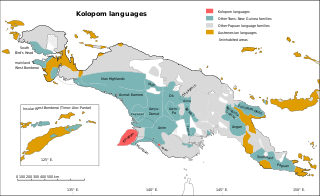Sulka is a language isolate of New Britain, Papua New Guinea. In 1991, there were 2,500 speakers in eastern Pomio District, East New Britain Province. Villages include Guma in East Pomio Rural LLG. With such a low population of speakers, this language is considered to be endangered. Sulka speakers had originally migrated to East New Britain from New Ireland.
The Burmeso language – also known as Taurap – is spoken by some 300 people in Burmeso village along the mid Mamberamo River in Mamberamo Tengah subdistrict, Mamberamo Raya Regency, Papua province, Indonesia. It is surrounded by the Kwerba languages to the north, the Lakes Plain languages to the south, and the East Cenderawasih Bay languages to the west.
The Ndu languages are the best known family of the Sepik languages of East Sepik Province in northern Papua New Guinea. Ndu is the word for 'man' in the languages that make up this group. The languages were first identified as a related family by Kirschbaum in 1922.
Usku, or Afra, is a nearly extinct and poorly documented Papuan language spoken by 20 or more people, mostly adults, in Usku village, Senggi District, Keerom Regency, Papua, Indonesia.
Adzera is an Austronesian language spoken by about 30,000 people in Morobe Province, Papua New Guinea.
The Pauwasi languages are a likely family of Papuan languages, mostly in Indonesia. The subfamilies are at best only distantly related. The best described Pauwasi language is Karkar, across the border in Papua New Guinea. They are spoken around the headwaters of the Pauwasi River in the Indonesian-PNG border region.

The Lower Sepik a.k.a. Nor–Pondo languages are a small language family of East Sepik Province in northern Papua New Guinea. They were identified as a family by K Laumann in 1951 under the name Nor–Pondo, and included in Donald Laycock's now-defunct 1973 Sepik–Ramu family.

The Middle Sepik languages comprise diverse groups of Sepik languages spoken in northern Papua New Guinea. The Middle Sepik grouping is provisionally accepted by Foley (2018) based on shared innovations in pronouns, but is divided by Glottolog. They are spoken in areas surrounding the town of Ambunti in East Sepik Province.

The Kolopom languages are a family of Trans–New Guinea languages in the classifications of Stephen Wurm (1975) and of Malcolm Ross (2005). Along with the Mombum languages, they are the languages spoken on Yos Sudarso Island.
The Demta–Sentani languages form a language family of coastal Indonesian Papua near the Papua New Guinea border.
Abun, also known as Yimbun, Anden, Manif, or Karon Pantai, is a Papuan language spoken by the Abun people along the northern coast of the Bird's Head Peninsula in Sausapor District, Tambrauw Regency. It is not closely related to any other language, and though Ross (2005) assigned it to the West Papuan family, based on similarities in pronouns, Palmer (2018), Ethnologue, and Glottolog list it as a language isolate.
Massep is a poorly documented Papuan language spoken by fewer than 50 people in the single village of Masep in West Pantai District, Sarmi Regency, Papua. Despite the small number of speakers, however, language use is vigorous. It is surrounded by the Kwerba languages Airoran and Samarokena.
The Orya–Tor languages are a family of just over a dozen Papuan languages spoken in Western New Guinea, Indonesia.
Lepki is a Papuan language spoken in Western New Guinea, near its relatives Murkim and Kembra. Only a few hundred words have been recorded, in hastily collected word lists.
Murkim is a Papuan language of Western New Guinea, near its relatives Lepki and Kembra. Though spoken by fewer than 300 people, it is being learned by children. It is spoken in Murkim District, Pegunungan Bintang Regency, Papua Province, Indonesia.
The Suabo or Inanwatan is a Papuan language of West Papua. It is often classified in the South Bird's Head language family, but may alternatively form an independent language family together with Duriankere.
Mawes is a Papuan language of Indonesia.
Yetfa and Biksi are dialects of a language spoken in Jetfa District, Papua, Indonesia, and across the border in Papua New Guinea. It is a trade language spoken in West Papua up to the PNG border.
The South Pauwasi languages are a likely small language family of New Guinea, potentially consisting of Yetfa, Kimki, Lepki, Murkim and Kembra.
The Lepki–Murkim languages are a pair to three recently discovered languages of New Guinea, Lepki, Murkim and possibly Kembra.



